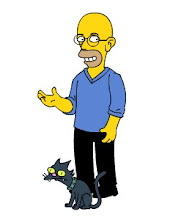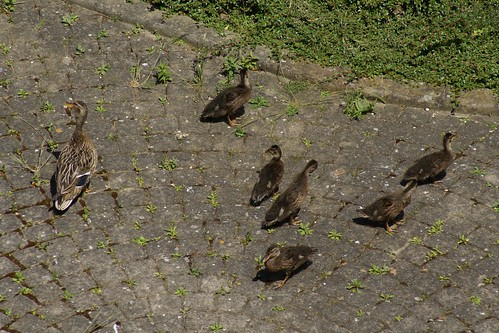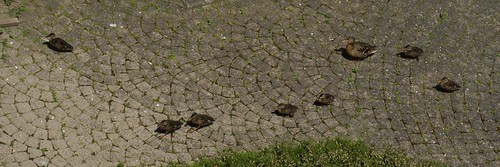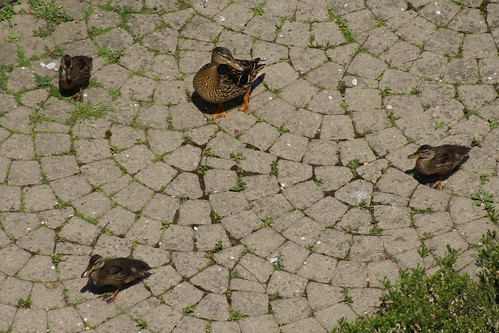Wednesday, 24 June 2009
7 : 3 : 1
It looks like we have eleven ducklings in the quad. The seven older juveniles from the first brood are still very much with us, and are getting pretty large now. The two more recent broods have been decimated, however. One appears to consist of only three ducklings, while the other is down to a single chick. That does mean that each duckling gets more attention/assistance from its mother, but with the first brood getting quite large, competition looks quite strong in the quad. It may be that feeding is more regular this year, but the strong truncation of the more recent broods while the first one stays at full strength suggests that competition is key (... says the armchair ecologist).
Monday, 22 June 2009
Seagull chicks
Returning from holiday finds a pair (or possibly three) of seagull chicks on the roof opposite. More or less in the same position as last year. Given their age, the chicks are suitably ugly and unkempt in appearance.
As for the ducks, well, I've not managed a convincing head-count yet, but it looks like all of the older chicks and some of the younger ones are still in the quad. There certainly aren't as many of the younger ones as when I left, but they're not extinct either.
As for the ducks, well, I've not managed a convincing head-count yet, but it looks like all of the older chicks and some of the younger ones are still in the quad. There certainly aren't as many of the younger ones as when I left, but they're not extinct either.
Sunday, 21 June 2009
The Invaders?
Time for another entry (and the final one to date) in John Varley's ongoing Red Thunder / Red Lightning series, Rolling Thunder. This was actually the first of the series that I received (a 2008 Christmas present), but I thought that I'd better reader the preceding novels before getting to it.
 Again advancing in time by a single generation, Rolling Thunder is narrated by Patricia Kelly Elizabeth Podkayne Strickland-Garcia-Redmond, or Poddy for short. As her mouthful of a surname implies, she is the grand-daughter of Mannie Garcia, narrator of Red Thunder, and one of the first humans to walk on Mars. The novel begins with her stationed in a consulate office in California, screening then routinely turning down applications from "Earthies" to emigrate to her home planet, Mars. Though tensions between Earth and Mars have eased since the events of Red Lightning, the planets still regard one another suspiciously, especially since Mars now controls the "squeezer" technology that has made space accessible to humanity. However, Poddy's life is less concerned with interplanetary politics than with slaving away under Earth's gravity, far away from her family and friends on Mars.
Again advancing in time by a single generation, Rolling Thunder is narrated by Patricia Kelly Elizabeth Podkayne Strickland-Garcia-Redmond, or Poddy for short. As her mouthful of a surname implies, she is the grand-daughter of Mannie Garcia, narrator of Red Thunder, and one of the first humans to walk on Mars. The novel begins with her stationed in a consulate office in California, screening then routinely turning down applications from "Earthies" to emigrate to her home planet, Mars. Though tensions between Earth and Mars have eased since the events of Red Lightning, the planets still regard one another suspiciously, especially since Mars now controls the "squeezer" technology that has made space accessible to humanity. However, Poddy's life is less concerned with interplanetary politics than with slaving away under Earth's gravity, far away from her family and friends on Mars.
Although officially conscripted in the Navy of the Martian Republic, Poddy's first love lies in composing popular music, and she jumps at the chance to form a "military band" to provide entertainment for the Navy bases located on the various moons of Jupiter. Poddy's first stop is Europa, where Navy scientists have spent years studying bizarre "living mountains" that grow where the moon's icy crust is thinnest. She becomes intrigued by the periodic, low frequency radio emissions that these strange crystalline organisms emit, and begins incorporating them into her compositions. As her tour takes her away from Europa and around other satellites of Jupiter, the band's reputation gradually takes off, first within the Navy bases, and then on the net. However, disaster strikes Poddy on her return to Europa where the mountains have begun to become more active. A routine journey over the surface of the moon is catastrophically curtailed when the mountains launch into space. Poddy is saved by the time-freezing "stopper" technology developed by her genius "uncle" Jubal, but remains trapped in stasis under the Europan ice for almost a decade before even her highly-connected family can finally rescue her.
This intervening period has been very kind to Poddy, whose compositions have come to dominate the music charts, and have made her very, very rich. But, by stark contrast, they have been very unkind to the Earth. After leaving Europa, the crystal mountains defied expectations by first visiting the high atmosphere of Jupiter before settling into the oceans of Earth, unable to be opposed by any weaponry that humanity could dream up. Now, for ends that no-one understands, the mountains are transforming the Earth's climate, rendering it uninhabitable for the humans still there. Through another "uncle", the former astronaut Travis Broussard, Poddy discovers that Jubal, Travis' cousin, has been brought out of "stopper" storage to try to come up with a solution for the deteriorating situation. However, he cannot find any way to tackle them, but instead uncovers a strange side-effect of the "stoppers" that Poddy has also experienced. Though ostensibly timeless, both Jubal and Poddy have dreamlike experiences that point to consignment in a "stopper" somehow exposing human minds to the perceptual continuum that the crystal mountains experience. Linking the mountains to a regular series of extinction events on the Earth, Jubal comes to understand the vastly different time-scales that they perceive the universe on. This realisation convinces Jubal that all of the efforts of humanity directed at the crystal mountains are no more than those of an insect against an elephant. Faced with such an unaware and unyielding foe, humankind and the resources that support it are destined to be squeezed to breaking point. Travis accepts Jubal's interpretation and, making use of Poddy's vast riches, plans a new future away from the perilous solar system.
Unlike the earlier two novels, this one significantly ups the science fiction content of the series. The crystal mountains and their glacially-slow perception of time certainly qualify in the "aliens" department. Similarly, the near-future and near-Earth antics of Red Thunder/Lightning are replaced with more exotic locales from the outer solar system and interstellar travel. This all stacks up in the plus column for me.
However, also unlike the earlier novels, this one has a few entries in the minus column. None of these are significant, and they really reflect my own pet peeves in books. For instance, in making Poddy a musician, Varley needs to describe her music so winds up indulging in name-checking of (I presume) artists that he likes, peppered with a few artists yet to be born. This, and other music-related flim-flam, just doesn't appeal to me, since the writing seems less about the fictional character and more about the author. Challenging for the fourth wall. I think Varley also drops the ball with his late-in-the-game romance for Poddy. While I'm certain that he didn't intend it this way, I couldn't quite overlook the notion that this might be a bit of wish-fulfilment on his part. That's an unkind reading, but I doubt I'm the only person to join those dots.
All that said, the plus column still wins out. Much as with the earlier novels, Poddy is generally a well-realised narrator, one who's fun to be around. I could have done with less (or no!) music in the novel, but as this isn't a common motif in novels, it's still interesting. I certainly appreciated the extra science fiction, although I did spend much of the novel labouring under the self-inflicted misapprehension that the crystal mountains were the Invaders of Varley's future-set Eight Worlds.
Finally, I don't know if Varley intends another novel in this series. The ending here moves things away from much that's familiar, so any successor novel will be shifted even further to the science fiction end of the spectrum. While that would appeal to my tastes for space aliens and other stars, it might also move the series too far from its realistic, near-future origins. As "juvenile" novels dealing with characters, language and events that are halfway plausible, the earlier two books serve as "gateways" to science fiction for younger readers averse to diving into fantastical futures. I guess we'll see. I'm really hoping that he turns his attention to the long-promised, and Eight Worlds-set, Irontown Blues.
In passing, I have to remark that the Invaders are among my favourite of aliens in science fiction literature. They turn up at Earth, note that we're messing up the planet for sentient organisms such as whales and dolphins that share their three dimensional view of reality, then shutdown our technology to stop us from causing any more trouble. They don't wipe humanity out, although they do end civilisation on Earth, and they leave the solar system colonies intact. And then, when humanity mobilises against them from Luna, they throw us another lifeline, singularity technology, to take us out of the solar system before they get seriously annoyed. They combine a respect for other sentient intelligences with truly alien perceptions of time and space. And, as a biologist bemoaning our entry into an environmentally calamitous Anthropocene, I'm a sucker for all that. That, and representing a reminder that our self-perception may be somewhat self-aggrandising (to say the least), makes them a memorable creation.
 Again advancing in time by a single generation, Rolling Thunder is narrated by Patricia Kelly Elizabeth Podkayne Strickland-Garcia-Redmond, or Poddy for short. As her mouthful of a surname implies, she is the grand-daughter of Mannie Garcia, narrator of Red Thunder, and one of the first humans to walk on Mars. The novel begins with her stationed in a consulate office in California, screening then routinely turning down applications from "Earthies" to emigrate to her home planet, Mars. Though tensions between Earth and Mars have eased since the events of Red Lightning, the planets still regard one another suspiciously, especially since Mars now controls the "squeezer" technology that has made space accessible to humanity. However, Poddy's life is less concerned with interplanetary politics than with slaving away under Earth's gravity, far away from her family and friends on Mars.
Again advancing in time by a single generation, Rolling Thunder is narrated by Patricia Kelly Elizabeth Podkayne Strickland-Garcia-Redmond, or Poddy for short. As her mouthful of a surname implies, she is the grand-daughter of Mannie Garcia, narrator of Red Thunder, and one of the first humans to walk on Mars. The novel begins with her stationed in a consulate office in California, screening then routinely turning down applications from "Earthies" to emigrate to her home planet, Mars. Though tensions between Earth and Mars have eased since the events of Red Lightning, the planets still regard one another suspiciously, especially since Mars now controls the "squeezer" technology that has made space accessible to humanity. However, Poddy's life is less concerned with interplanetary politics than with slaving away under Earth's gravity, far away from her family and friends on Mars. Although officially conscripted in the Navy of the Martian Republic, Poddy's first love lies in composing popular music, and she jumps at the chance to form a "military band" to provide entertainment for the Navy bases located on the various moons of Jupiter. Poddy's first stop is Europa, where Navy scientists have spent years studying bizarre "living mountains" that grow where the moon's icy crust is thinnest. She becomes intrigued by the periodic, low frequency radio emissions that these strange crystalline organisms emit, and begins incorporating them into her compositions. As her tour takes her away from Europa and around other satellites of Jupiter, the band's reputation gradually takes off, first within the Navy bases, and then on the net. However, disaster strikes Poddy on her return to Europa where the mountains have begun to become more active. A routine journey over the surface of the moon is catastrophically curtailed when the mountains launch into space. Poddy is saved by the time-freezing "stopper" technology developed by her genius "uncle" Jubal, but remains trapped in stasis under the Europan ice for almost a decade before even her highly-connected family can finally rescue her.
This intervening period has been very kind to Poddy, whose compositions have come to dominate the music charts, and have made her very, very rich. But, by stark contrast, they have been very unkind to the Earth. After leaving Europa, the crystal mountains defied expectations by first visiting the high atmosphere of Jupiter before settling into the oceans of Earth, unable to be opposed by any weaponry that humanity could dream up. Now, for ends that no-one understands, the mountains are transforming the Earth's climate, rendering it uninhabitable for the humans still there. Through another "uncle", the former astronaut Travis Broussard, Poddy discovers that Jubal, Travis' cousin, has been brought out of "stopper" storage to try to come up with a solution for the deteriorating situation. However, he cannot find any way to tackle them, but instead uncovers a strange side-effect of the "stoppers" that Poddy has also experienced. Though ostensibly timeless, both Jubal and Poddy have dreamlike experiences that point to consignment in a "stopper" somehow exposing human minds to the perceptual continuum that the crystal mountains experience. Linking the mountains to a regular series of extinction events on the Earth, Jubal comes to understand the vastly different time-scales that they perceive the universe on. This realisation convinces Jubal that all of the efforts of humanity directed at the crystal mountains are no more than those of an insect against an elephant. Faced with such an unaware and unyielding foe, humankind and the resources that support it are destined to be squeezed to breaking point. Travis accepts Jubal's interpretation and, making use of Poddy's vast riches, plans a new future away from the perilous solar system.
Unlike the earlier two novels, this one significantly ups the science fiction content of the series. The crystal mountains and their glacially-slow perception of time certainly qualify in the "aliens" department. Similarly, the near-future and near-Earth antics of Red Thunder/Lightning are replaced with more exotic locales from the outer solar system and interstellar travel. This all stacks up in the plus column for me.
However, also unlike the earlier novels, this one has a few entries in the minus column. None of these are significant, and they really reflect my own pet peeves in books. For instance, in making Poddy a musician, Varley needs to describe her music so winds up indulging in name-checking of (I presume) artists that he likes, peppered with a few artists yet to be born. This, and other music-related flim-flam, just doesn't appeal to me, since the writing seems less about the fictional character and more about the author. Challenging for the fourth wall. I think Varley also drops the ball with his late-in-the-game romance for Poddy. While I'm certain that he didn't intend it this way, I couldn't quite overlook the notion that this might be a bit of wish-fulfilment on his part. That's an unkind reading, but I doubt I'm the only person to join those dots.
All that said, the plus column still wins out. Much as with the earlier novels, Poddy is generally a well-realised narrator, one who's fun to be around. I could have done with less (or no!) music in the novel, but as this isn't a common motif in novels, it's still interesting. I certainly appreciated the extra science fiction, although I did spend much of the novel labouring under the self-inflicted misapprehension that the crystal mountains were the Invaders of Varley's future-set Eight Worlds.
Finally, I don't know if Varley intends another novel in this series. The ending here moves things away from much that's familiar, so any successor novel will be shifted even further to the science fiction end of the spectrum. While that would appeal to my tastes for space aliens and other stars, it might also move the series too far from its realistic, near-future origins. As "juvenile" novels dealing with characters, language and events that are halfway plausible, the earlier two books serve as "gateways" to science fiction for younger readers averse to diving into fantastical futures. I guess we'll see. I'm really hoping that he turns his attention to the long-promised, and Eight Worlds-set, Irontown Blues.
In passing, I have to remark that the Invaders are among my favourite of aliens in science fiction literature. They turn up at Earth, note that we're messing up the planet for sentient organisms such as whales and dolphins that share their three dimensional view of reality, then shutdown our technology to stop us from causing any more trouble. They don't wipe humanity out, although they do end civilisation on Earth, and they leave the solar system colonies intact. And then, when humanity mobilises against them from Luna, they throw us another lifeline, singularity technology, to take us out of the solar system before they get seriously annoyed. They combine a respect for other sentient intelligences with truly alien perceptions of time and space. And, as a biologist bemoaning our entry into an environmentally calamitous Anthropocene, I'm a sucker for all that. That, and representing a reminder that our self-perception may be somewhat self-aggrandising (to say the least), makes them a memorable creation.
Friday, 19 June 2009
Brecon Beacons, day 6
Our last proper day on holiday. Rather than drive to a far-off hike, we picked a close one that we've driven passed a number of times this trip. Well, that was the plan anyway. When we arrived at Talybont Reservoir, it turned out that the builders were in (waterworks?) and our hike's carpark was off limits. Undeterred, we drove a "bit" further to the next carpark and began our hike from there instead. It only added 2 km to the hike ...
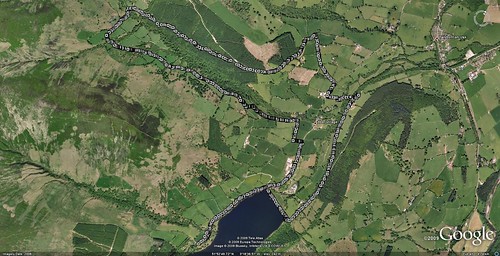
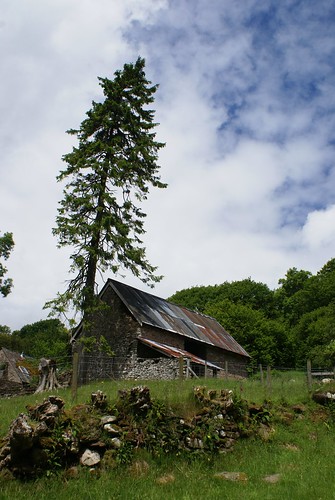 Although this hike used yet another reservoir as a start point, the first, and longest, part of the route actually ran away from the reservoir up an adjacent valley. This took in farm roads so the route was very easy to follow, and with only one and a half small farms operating in the valley, it was also deathly quiet. The upward leg took us mostly passed fields or through deciduous forest, while the downward leg spent some time in dense coniferous forest [*]. Though we didn't meet (m)any other people, we did bump into a lot of sheep. We managed, at one point, to get into a maternal stand-off with one ewe and her lamb by accidentally getting between them. This turned into an epic as we tried to reach part of the route wide enough for the ewe that was following us to actually get around us. For ostensibly domesticated animals, the sheep were rather untrusting and wary of us - then again, given their ultimate fate, perhaps they were just one step ahead of us.
Although this hike used yet another reservoir as a start point, the first, and longest, part of the route actually ran away from the reservoir up an adjacent valley. This took in farm roads so the route was very easy to follow, and with only one and a half small farms operating in the valley, it was also deathly quiet. The upward leg took us mostly passed fields or through deciduous forest, while the downward leg spent some time in dense coniferous forest [*]. Though we didn't meet (m)any other people, we did bump into a lot of sheep. We managed, at one point, to get into a maternal stand-off with one ewe and her lamb by accidentally getting between them. This turned into an epic as we tried to reach part of the route wide enough for the ewe that was following us to actually get around us. For ostensibly domesticated animals, the sheep were rather untrusting and wary of us - then again, given their ultimate fate, perhaps they were just one step ahead of us.
 After completing the downward part of the valley on our route, we eventually crossed the River Usk to reach an abandoned railway. Or, rather, we were supposed to reach an abandoned quarry's tramline some way beyond the railway, but faced with another upward hike to reach it we stopped at the railway. As it turns out, we shouldn't have, since it was now a private road (complete with barbed wire and a sign), but we only found this out at the very end. Oh well. From here we finished up by walking back along the reservoir's dam. In an interesting development, local inhabitants have gotten a generator up and running at the dam, so it now generates about a quarter of Talybont's electricity (if I remember correctly).
After completing the downward part of the valley on our route, we eventually crossed the River Usk to reach an abandoned railway. Or, rather, we were supposed to reach an abandoned quarry's tramline some way beyond the railway, but faced with another upward hike to reach it we stopped at the railway. As it turns out, we shouldn't have, since it was now a private road (complete with barbed wire and a sign), but we only found this out at the very end. Oh well. From here we finished up by walking back along the reservoir's dam. In an interesting development, local inhabitants have gotten a generator up and running at the dam, so it now generates about a quarter of Talybont's electricity (if I remember correctly).
We finished up the day's exertions with a late lunch at Talybont's White Hart pub, and a canal-side pint. Then it was back to our holiday home for some tidying up (and some time-lapse experiments with birds).
[*] I was struck again the different in density between these forests. While the deciduous forest intercepted much of the available sunlight, the coniferous forest intercepted just about all of it. Its floor was bordering on dusk levels of light, largely down to the spacing of the trees. Its floor was also conspicuously lacking in biodiversity, and piled high with fallen needle leaves. The latter point got me wondering about recycling in coniferous forests. With biomass accumulating and recycling low, presumably coniferous forests might exhaust or greatly diminish free soil nutrients. Which, again presumably, must eventually limit their growth. I've never read up on it, so this is just idle speculation, but perhaps coniferous forests expand and retreat in waves? They grow until they deplete an area, at which point they decline, letting other species in and kick-starting recycling, but ultimately recreating the conditions that allow the conifers to return and begin the cycle again. Then again, perhaps the coniferous forests that we saw are (anthropogenically) stocked at abnormally high densities?

 Although this hike used yet another reservoir as a start point, the first, and longest, part of the route actually ran away from the reservoir up an adjacent valley. This took in farm roads so the route was very easy to follow, and with only one and a half small farms operating in the valley, it was also deathly quiet. The upward leg took us mostly passed fields or through deciduous forest, while the downward leg spent some time in dense coniferous forest [*]. Though we didn't meet (m)any other people, we did bump into a lot of sheep. We managed, at one point, to get into a maternal stand-off with one ewe and her lamb by accidentally getting between them. This turned into an epic as we tried to reach part of the route wide enough for the ewe that was following us to actually get around us. For ostensibly domesticated animals, the sheep were rather untrusting and wary of us - then again, given their ultimate fate, perhaps they were just one step ahead of us.
Although this hike used yet another reservoir as a start point, the first, and longest, part of the route actually ran away from the reservoir up an adjacent valley. This took in farm roads so the route was very easy to follow, and with only one and a half small farms operating in the valley, it was also deathly quiet. The upward leg took us mostly passed fields or through deciduous forest, while the downward leg spent some time in dense coniferous forest [*]. Though we didn't meet (m)any other people, we did bump into a lot of sheep. We managed, at one point, to get into a maternal stand-off with one ewe and her lamb by accidentally getting between them. This turned into an epic as we tried to reach part of the route wide enough for the ewe that was following us to actually get around us. For ostensibly domesticated animals, the sheep were rather untrusting and wary of us - then again, given their ultimate fate, perhaps they were just one step ahead of us. After completing the downward part of the valley on our route, we eventually crossed the River Usk to reach an abandoned railway. Or, rather, we were supposed to reach an abandoned quarry's tramline some way beyond the railway, but faced with another upward hike to reach it we stopped at the railway. As it turns out, we shouldn't have, since it was now a private road (complete with barbed wire and a sign), but we only found this out at the very end. Oh well. From here we finished up by walking back along the reservoir's dam. In an interesting development, local inhabitants have gotten a generator up and running at the dam, so it now generates about a quarter of Talybont's electricity (if I remember correctly).
After completing the downward part of the valley on our route, we eventually crossed the River Usk to reach an abandoned railway. Or, rather, we were supposed to reach an abandoned quarry's tramline some way beyond the railway, but faced with another upward hike to reach it we stopped at the railway. As it turns out, we shouldn't have, since it was now a private road (complete with barbed wire and a sign), but we only found this out at the very end. Oh well. From here we finished up by walking back along the reservoir's dam. In an interesting development, local inhabitants have gotten a generator up and running at the dam, so it now generates about a quarter of Talybont's electricity (if I remember correctly).We finished up the day's exertions with a late lunch at Talybont's White Hart pub, and a canal-side pint. Then it was back to our holiday home for some tidying up (and some time-lapse experiments with birds).
[*] I was struck again the different in density between these forests. While the deciduous forest intercepted much of the available sunlight, the coniferous forest intercepted just about all of it. Its floor was bordering on dusk levels of light, largely down to the spacing of the trees. Its floor was also conspicuously lacking in biodiversity, and piled high with fallen needle leaves. The latter point got me wondering about recycling in coniferous forests. With biomass accumulating and recycling low, presumably coniferous forests might exhaust or greatly diminish free soil nutrients. Which, again presumably, must eventually limit their growth. I've never read up on it, so this is just idle speculation, but perhaps coniferous forests expand and retreat in waves? They grow until they deplete an area, at which point they decline, letting other species in and kick-starting recycling, but ultimately recreating the conditions that allow the conifers to return and begin the cycle again. Then again, perhaps the coniferous forests that we saw are (anthropogenically) stocked at abnormally high densities?
Thursday, 18 June 2009
Brecon Beacons, day 5
Waterfall walks today. Southwest of Brecon, there's an area around the village of Ystradfellte with a large number of falls. On our last visit we took in probably one of the largest falls, but my blister situation prevented us from seeing any of the others. This time round, my boots were more broken-in, and I was using a balm that C got me on my heels. Judging from the lack of problems I've had on this trip, the latter seems to have been pretty effective.
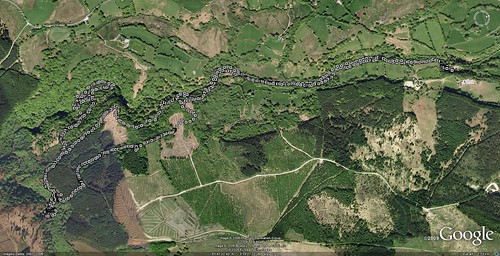
 Anyway, we did two separate walks the first a quasi-circular one close to Ystradfellte that took in about five relatively large falls, including the one we did last time. Though it wasn't the largest, the highlight was one waterfall which actually allowed us to walk behind it. That was pretty impressive. While we'd been hoping that yesterday's wet weather would have upped flow rates, it still didn't appear to be going at full speed, but it was still well worth the rather steep trip down the valley to see it and get behind it.
Anyway, we did two separate walks the first a quasi-circular one close to Ystradfellte that took in about five relatively large falls, including the one we did last time. Though it wasn't the largest, the highlight was one waterfall which actually allowed us to walk behind it. That was pretty impressive. While we'd been hoping that yesterday's wet weather would have upped flow rates, it still didn't appear to be going at full speed, but it was still well worth the rather steep trip down the valley to see it and get behind it.

 The second hike was a few miles to the south of the first, and a more linear trail that took us back up the river to a succession of falls. They were all really good, especially the final one, but by this point waterfall apathy was beginning to set in. It seems like no matter how cool something is, and I'm a big waterfall fan, seeing ten of them in a row in a single day does tend to remove the shine a bit.
The second hike was a few miles to the south of the first, and a more linear trail that took us back up the river to a succession of falls. They were all really good, especially the final one, but by this point waterfall apathy was beginning to set in. It seems like no matter how cool something is, and I'm a big waterfall fan, seeing ten of them in a row in a single day does tend to remove the shine a bit.
One amusing aspect of the hikes was that we kept meeting the same groups of people on the trails time and time again. One couple (plus their dog) we met about four times, so it became a running joke between us. This isn't really all that surprising given that the falls are both the main attraction for the area and that they're necessarily all linked up on the same rivers, but is still gave us a sense of deja vu to repeatedly (re-)meet people we thought we'd last seen going the other way.
This evening we delved into the house's video library with U.S. Marshals, the non-sequel sequel to the much better received 1993 film The Fugative. The box blurb scrupulously avoided suggesting it was a sequel (presumably on intellectual property grounds), but couldn't resist saying "If you liked The Fugative, you'll love this". One would think that the identical-but-for-Harrison-Ford cast might permit the charade to be dropped, but apparently not. Anyway, while certainly an inferior film, it wasn't at all bad - though its carefully twisted plot stuck sufficiently tightly to convention for us to deduce all but one of its key details by about five minutes in. The detail that we missed stemmed from our steadfast conviction of the guilt of a character played by a UK actor with a dodgy American accent. You just can't trust those dastardly Brits.

 Anyway, we did two separate walks the first a quasi-circular one close to Ystradfellte that took in about five relatively large falls, including the one we did last time. Though it wasn't the largest, the highlight was one waterfall which actually allowed us to walk behind it. That was pretty impressive. While we'd been hoping that yesterday's wet weather would have upped flow rates, it still didn't appear to be going at full speed, but it was still well worth the rather steep trip down the valley to see it and get behind it.
Anyway, we did two separate walks the first a quasi-circular one close to Ystradfellte that took in about five relatively large falls, including the one we did last time. Though it wasn't the largest, the highlight was one waterfall which actually allowed us to walk behind it. That was pretty impressive. While we'd been hoping that yesterday's wet weather would have upped flow rates, it still didn't appear to be going at full speed, but it was still well worth the rather steep trip down the valley to see it and get behind it.
 The second hike was a few miles to the south of the first, and a more linear trail that took us back up the river to a succession of falls. They were all really good, especially the final one, but by this point waterfall apathy was beginning to set in. It seems like no matter how cool something is, and I'm a big waterfall fan, seeing ten of them in a row in a single day does tend to remove the shine a bit.
The second hike was a few miles to the south of the first, and a more linear trail that took us back up the river to a succession of falls. They were all really good, especially the final one, but by this point waterfall apathy was beginning to set in. It seems like no matter how cool something is, and I'm a big waterfall fan, seeing ten of them in a row in a single day does tend to remove the shine a bit.One amusing aspect of the hikes was that we kept meeting the same groups of people on the trails time and time again. One couple (plus their dog) we met about four times, so it became a running joke between us. This isn't really all that surprising given that the falls are both the main attraction for the area and that they're necessarily all linked up on the same rivers, but is still gave us a sense of deja vu to repeatedly (re-)meet people we thought we'd last seen going the other way.
This evening we delved into the house's video library with U.S. Marshals, the non-sequel sequel to the much better received 1993 film The Fugative. The box blurb scrupulously avoided suggesting it was a sequel (presumably on intellectual property grounds), but couldn't resist saying "If you liked The Fugative, you'll love this". One would think that the identical-but-for-Harrison-Ford cast might permit the charade to be dropped, but apparently not. Anyway, while certainly an inferior film, it wasn't at all bad - though its carefully twisted plot stuck sufficiently tightly to convention for us to deduce all but one of its key details by about five minutes in. The detail that we missed stemmed from our steadfast conviction of the guilt of a character played by a UK actor with a dodgy American accent. You just can't trust those dastardly Brits.
Wednesday, 17 June 2009
Brecon Beacons, day 4
Although not quite as bad as that predicted by the Met Office, Wednesday’s weather was a turn for the worse. Far from ideal for hiking, but we’d already decided to do “culture” instead anyway. As it happens, a toe-stubbing incident on C’s part made hiking a liability regardless of the weather.
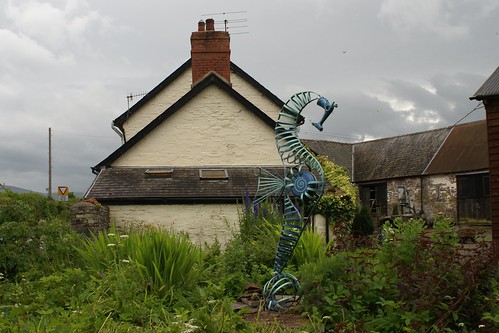 Our first stop was a craft centre in a short drive north in Erwood. This centre was based around a defunct railway station that was bought up by a professional wood-turner in 1984 and converted into a venue for local artists to display and sell their work. It currently has around 70 artists represented, covering a wide range including painting, stonework, jewellery, woodwork and photography. The selection on display was pretty impressive, and we came away with some jewellery (obviously I didn’t) and a rather tactile soapstone sculpture. Just as we were leaving we got chatting to what turned out to be the centre’s operator. He was in his early 20s, and it transpired that the centre was the creation of his father who, unfortunately, had recently died. Trained up by his father as a wood-turner, he had decided to try his hand at creating his own work and to continue the centre. Quite a challenge I’d have thought, but an admirable one, and made somewhat easier by the strong roster of artists represented by the centre.
Our first stop was a craft centre in a short drive north in Erwood. This centre was based around a defunct railway station that was bought up by a professional wood-turner in 1984 and converted into a venue for local artists to display and sell their work. It currently has around 70 artists represented, covering a wide range including painting, stonework, jewellery, woodwork and photography. The selection on display was pretty impressive, and we came away with some jewellery (obviously I didn’t) and a rather tactile soapstone sculpture. Just as we were leaving we got chatting to what turned out to be the centre’s operator. He was in his early 20s, and it transpired that the centre was the creation of his father who, unfortunately, had recently died. Trained up by his father as a wood-turner, he had decided to try his hand at creating his own work and to continue the centre. Quite a challenge I’d have thought, but an admirable one, and made somewhat easier by the strong roster of artists represented by the centre.
Our next stop was a sort of art-trail through the twisting streets of Brecon. For a town of its size, it’s well-provisioned with galleries and small art shops. None were as good as the Erwood centre, but there was one, Oh!, with some great sculpture in it. The most distinctive pieces combined natural materials like mollusc shells and sand into bowls and lampshades using epoxy resin. Essentially, useful objects that are far too attractive and valuable to be used for their ostensible purposes.
 Our first stop was a craft centre in a short drive north in Erwood. This centre was based around a defunct railway station that was bought up by a professional wood-turner in 1984 and converted into a venue for local artists to display and sell their work. It currently has around 70 artists represented, covering a wide range including painting, stonework, jewellery, woodwork and photography. The selection on display was pretty impressive, and we came away with some jewellery (obviously I didn’t) and a rather tactile soapstone sculpture. Just as we were leaving we got chatting to what turned out to be the centre’s operator. He was in his early 20s, and it transpired that the centre was the creation of his father who, unfortunately, had recently died. Trained up by his father as a wood-turner, he had decided to try his hand at creating his own work and to continue the centre. Quite a challenge I’d have thought, but an admirable one, and made somewhat easier by the strong roster of artists represented by the centre.
Our first stop was a craft centre in a short drive north in Erwood. This centre was based around a defunct railway station that was bought up by a professional wood-turner in 1984 and converted into a venue for local artists to display and sell their work. It currently has around 70 artists represented, covering a wide range including painting, stonework, jewellery, woodwork and photography. The selection on display was pretty impressive, and we came away with some jewellery (obviously I didn’t) and a rather tactile soapstone sculpture. Just as we were leaving we got chatting to what turned out to be the centre’s operator. He was in his early 20s, and it transpired that the centre was the creation of his father who, unfortunately, had recently died. Trained up by his father as a wood-turner, he had decided to try his hand at creating his own work and to continue the centre. Quite a challenge I’d have thought, but an admirable one, and made somewhat easier by the strong roster of artists represented by the centre.Our next stop was a sort of art-trail through the twisting streets of Brecon. For a town of its size, it’s well-provisioned with galleries and small art shops. None were as good as the Erwood centre, but there was one, Oh!, with some great sculpture in it. The most distinctive pieces combined natural materials like mollusc shells and sand into bowls and lampshades using epoxy resin. Essentially, useful objects that are far too attractive and valuable to be used for their ostensible purposes.
Tuesday, 16 June 2009
Brecon Beacons, day 3
 Because of a bad forecast for Wednesday’s weather, we decided to knock-off Pen-y-Fan et al. today. As the guidebooks variously listed our favoured walk as 6 or 7 miles, but were consistent on it as “strenuous”, we decided to get up and off as quickly as we could. Our plans were almost halted by the thick fog that had descended overnight, but by 8:30am this appeared to be in full retreat so we set off. As it happens, by the time we reached the altitude of our start point, the Lower Neuadd Reservoir, it had lifted entirely.
Because of a bad forecast for Wednesday’s weather, we decided to knock-off Pen-y-Fan et al. today. As the guidebooks variously listed our favoured walk as 6 or 7 miles, but were consistent on it as “strenuous”, we decided to get up and off as quickly as we could. Our plans were almost halted by the thick fog that had descended overnight, but by 8:30am this appeared to be in full retreat so we set off. As it happens, by the time we reached the altitude of our start point, the Lower Neuadd Reservoir, it had lifted entirely.
 One of the attractions of our favoured route was that much of the heavy-lifting was scheduled for the outward leg of the hike. It didn’t disappoint. Almost immediately we scaled around 200 m, approximately half of the total. This took us up to a ridge that, bar one or two minor dips and crests, ultimately dropped us at the base of the final rise of Corn Du, peak 1 of the hike’s 3. Before we reached this though, we had a long march along the ridge that gave great views of all 3 peaks together with the valleys immediately adjacent to them. What it didn’t prepare us for, however, was the ferociousness of the midges that inhabited the peaks. Away from the peaks, there wasn’t a hint of insect life, but topside was a completely different story. So my usual dithering to take photographs was severely curtailed, no loss, I’m sure, for C. The views from all 3 tops were pretty impressive. The peaks are towards the northern edge of the Brecon Beacons, so the northward views extend pretty far. I took a panorama to try to capture this, but the midges proved quite a distraction, so we’ll have to see if that pans out. Pen-y-Fan was pretty easy to crest after dropping down from Corn Du, but reaching Cribyn was quite a struggle after a big drop before starting its ascent. Along the way we passed a crew of path-makers who were painstakingly building a path up the side of Pen-y-Fan. I don’t know how long this is going to take in total, but it must be most of this summer. Their handiwork was extremely welcome on the steep ascent to Cribyn though.
One of the attractions of our favoured route was that much of the heavy-lifting was scheduled for the outward leg of the hike. It didn’t disappoint. Almost immediately we scaled around 200 m, approximately half of the total. This took us up to a ridge that, bar one or two minor dips and crests, ultimately dropped us at the base of the final rise of Corn Du, peak 1 of the hike’s 3. Before we reached this though, we had a long march along the ridge that gave great views of all 3 peaks together with the valleys immediately adjacent to them. What it didn’t prepare us for, however, was the ferociousness of the midges that inhabited the peaks. Away from the peaks, there wasn’t a hint of insect life, but topside was a completely different story. So my usual dithering to take photographs was severely curtailed, no loss, I’m sure, for C. The views from all 3 tops were pretty impressive. The peaks are towards the northern edge of the Brecon Beacons, so the northward views extend pretty far. I took a panorama to try to capture this, but the midges proved quite a distraction, so we’ll have to see if that pans out. Pen-y-Fan was pretty easy to crest after dropping down from Corn Du, but reaching Cribyn was quite a struggle after a big drop before starting its ascent. Along the way we passed a crew of path-makers who were painstakingly building a path up the side of Pen-y-Fan. I don’t know how long this is going to take in total, but it must be most of this summer. Their handiwork was extremely welcome on the steep ascent to Cribyn though.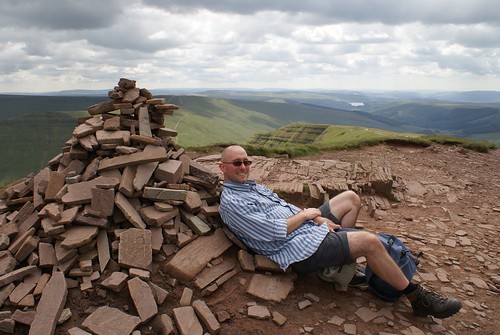 After topping Cribyn, and having a nice midge-free lunch on its sunny downward slope, it was downhill all the way. Our walk skipped Fan-y-big (the next peak in line), but after the precipitously stamina-draining rise to Cribyn, we’d have junked it ourselves even if the guidebook hadn’t. Certainly, Fan-y-big’s zigzagging ascent path wasn’t enticing to say the least. The downward path gave us good views of the route we’d taken – it all looked quite impressive, far more so than it probably should have! Hopefully the photographs I took will flatter our hiking credentials.
After topping Cribyn, and having a nice midge-free lunch on its sunny downward slope, it was downhill all the way. Our walk skipped Fan-y-big (the next peak in line), but after the precipitously stamina-draining rise to Cribyn, we’d have junked it ourselves even if the guidebook hadn’t. Certainly, Fan-y-big’s zigzagging ascent path wasn’t enticing to say the least. The downward path gave us good views of the route we’d taken – it all looked quite impressive, far more so than it probably should have! Hopefully the photographs I took will flatter our hiking credentials.After returning to Bwlch, we had a couple of hours sitting around in the garden and doing the Gruniad crossword before we headed off to the Dragon Inn in the nearby town of Crickhowell for dinner. When we visited the Brecon Beacons last year we stayed at this inn and had an excellent dinner there. It didn’t disappoint this time either, although it couldn’t have been any less busy than last time: then (a Saturday) we were lucky to get a table, this time (a Tuesday) we were the inn’s only diners. Still, unlike last time, this did mean that our dinner wasn’t interrupted by the arrival of an ambulance and the departure of a fellow diner.
Monday, 15 June 2009
Brecon Beacons, day 2
Not quite as early a start, but good for it being a holiday. We went for a longer walk today: a circular route around Pontsticill Reservoir to the south of Tal-y-bont (the town our holiday home is ostensibly part of). The road down to the reservoir was typical for rural Wales: basically single track with infrequent passing places and far more frequent blind bends. When we visited Wales last year, we actually got wedged in on a similar road, so proceeded very cautiously to Pontsticill. As it turns out, no hazards were encountered, but we still took the precaution of returning to Bwlch a different route.
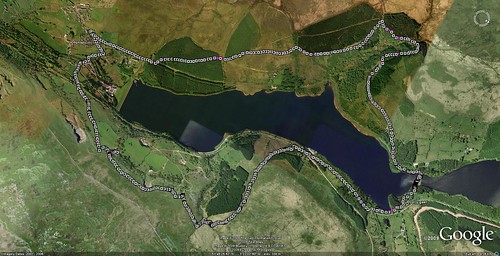
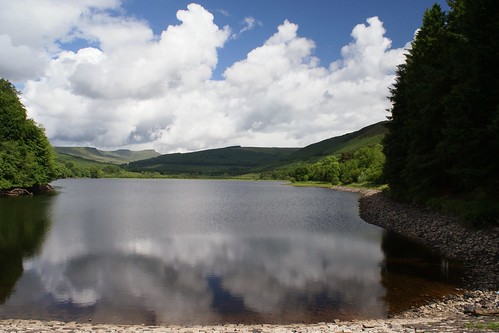 The hike started at the northern margin of the reservoir (actually where it met a smaller reservoir), and proceeded down its eastern flank, at times following a railway, before turning inland and upwards. This gave us really good views over the water, which seemed mostly being used for sailing and other water sports. This inland portion also had a number of nice little streams to photograph endlessly. After eventually locating the Gate Of The Blue Handle we descended towards the reservoir’s dam and the adjacent village of, surprise-surprise, Pontsticill. With faultlessly impeccable timing the rain started just as we reached a friendly looking pub (The Red Cow), which afforded us an ideal stopover while it passed over. The latter part of the hike was a lot less interesting, consisting of a long cycle track through the forested western flank of the reservoir. Fine for the 10 minutes that two wheeled transport would make of it, but exceedingly dull if you’re tramping through it on foot. The forest also blocked our view of the steam train running on the far side of the lake. Ace.
The hike started at the northern margin of the reservoir (actually where it met a smaller reservoir), and proceeded down its eastern flank, at times following a railway, before turning inland and upwards. This gave us really good views over the water, which seemed mostly being used for sailing and other water sports. This inland portion also had a number of nice little streams to photograph endlessly. After eventually locating the Gate Of The Blue Handle we descended towards the reservoir’s dam and the adjacent village of, surprise-surprise, Pontsticill. With faultlessly impeccable timing the rain started just as we reached a friendly looking pub (The Red Cow), which afforded us an ideal stopover while it passed over. The latter part of the hike was a lot less interesting, consisting of a long cycle track through the forested western flank of the reservoir. Fine for the 10 minutes that two wheeled transport would make of it, but exceedingly dull if you’re tramping through it on foot. The forest also blocked our view of the steam train running on the far side of the lake. Ace.
The rest of the afternoon was spent reading (C) or sleeping (moi) back at the house. Weather was, again, great. Probably managed to over-irradiate myself though. Dinner took us to a no-nonsense pub in Tal-y-bont (The White Hart). Cheap and cheerful was the order of the day.

 The hike started at the northern margin of the reservoir (actually where it met a smaller reservoir), and proceeded down its eastern flank, at times following a railway, before turning inland and upwards. This gave us really good views over the water, which seemed mostly being used for sailing and other water sports. This inland portion also had a number of nice little streams to photograph endlessly. After eventually locating the Gate Of The Blue Handle we descended towards the reservoir’s dam and the adjacent village of, surprise-surprise, Pontsticill. With faultlessly impeccable timing the rain started just as we reached a friendly looking pub (The Red Cow), which afforded us an ideal stopover while it passed over. The latter part of the hike was a lot less interesting, consisting of a long cycle track through the forested western flank of the reservoir. Fine for the 10 minutes that two wheeled transport would make of it, but exceedingly dull if you’re tramping through it on foot. The forest also blocked our view of the steam train running on the far side of the lake. Ace.
The hike started at the northern margin of the reservoir (actually where it met a smaller reservoir), and proceeded down its eastern flank, at times following a railway, before turning inland and upwards. This gave us really good views over the water, which seemed mostly being used for sailing and other water sports. This inland portion also had a number of nice little streams to photograph endlessly. After eventually locating the Gate Of The Blue Handle we descended towards the reservoir’s dam and the adjacent village of, surprise-surprise, Pontsticill. With faultlessly impeccable timing the rain started just as we reached a friendly looking pub (The Red Cow), which afforded us an ideal stopover while it passed over. The latter part of the hike was a lot less interesting, consisting of a long cycle track through the forested western flank of the reservoir. Fine for the 10 minutes that two wheeled transport would make of it, but exceedingly dull if you’re tramping through it on foot. The forest also blocked our view of the steam train running on the far side of the lake. Ace.The rest of the afternoon was spent reading (C) or sleeping (moi) back at the house. Weather was, again, great. Probably managed to over-irradiate myself though. Dinner took us to a no-nonsense pub in Tal-y-bont (The White Hart). Cheap and cheerful was the order of the day.
Sunday, 14 June 2009
Brecon Beacons, day 1
Got a bit of a shock from C: an early start. Though the windows are small, streaming sunlight elicited a prompt breakfast, and before long we were on the road.
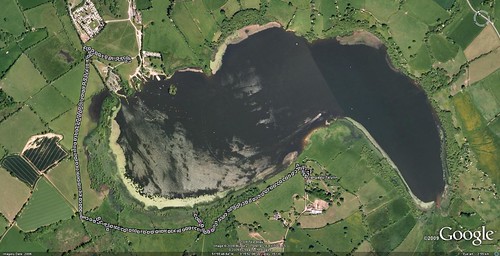
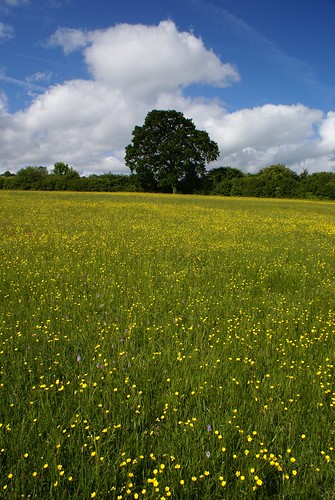 We thought we’d start with an easy hike, so took in an ostensibly lake-side walk not far up the road at Llangors. “Ostensibly” because trees and extensive reed beds kept the lake an invisible distance from us until near the end. The walk took in some unfertilised grasslands, which (we were told by a helpful forestry commission worker) allow a wider range of wild flowers, including some lovely little orchids. And we finished up at a pretty church, so a bumper crop of stained glass window photographs resulted.
We thought we’d start with an easy hike, so took in an ostensibly lake-side walk not far up the road at Llangors. “Ostensibly” because trees and extensive reed beds kept the lake an invisible distance from us until near the end. The walk took in some unfertilised grasslands, which (we were told by a helpful forestry commission worker) allow a wider range of wild flowers, including some lovely little orchids. And we finished up at a pretty church, so a bumper crop of stained glass window photographs resulted.
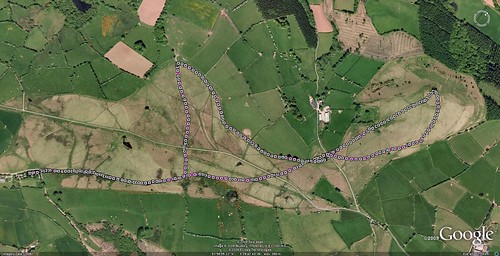
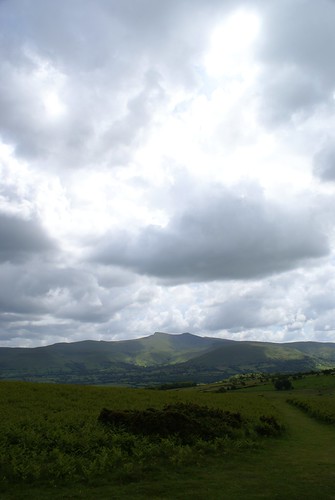 Next we drove out passed Brecon to visit the Mountain Centre that serves to provide information about the various peaks and hiking in the area. It also provided a rather nice lunch and another short-ish hike. This one took us north from the centre, up and down a bit before we finally reached a trig point and a panoramic photo-opportunity. Marginally more challenging than the lakeside walk, it also provided some good views of the distant Corn Du and Pen y Fan peaks that dominate the local skyline. The plan is to do these at some point in the week, but some degree of preparatory toughening-up of our hiking probably won’t go a miss first.
Next we drove out passed Brecon to visit the Mountain Centre that serves to provide information about the various peaks and hiking in the area. It also provided a rather nice lunch and another short-ish hike. This one took us north from the centre, up and down a bit before we finally reached a trig point and a panoramic photo-opportunity. Marginally more challenging than the lakeside walk, it also provided some good views of the distant Corn Du and Pen y Fan peaks that dominate the local skyline. The plan is to do these at some point in the week, but some degree of preparatory toughening-up of our hiking probably won’t go a miss first.

 The return journey took in a provisions-run to Brecon before some home-cooked pasta eaten classily from large pyrex bowls – the house is somewhat less well-provisioned in specialist crockery. After dinner I plotted a short walk along the paths immediately around the house. However, the resulting journey was less straightforward than my OS plans suggested. In particular, a rather long stretch down a “Roman Road” was an overgrown trudge through a soup of insects. Similarly, the clear, diagonal home-straight on paper was actually an indistinct path across a rather sheep-soiled field. Still, in the end it mostly went to plan, despite C’s protestations.
The return journey took in a provisions-run to Brecon before some home-cooked pasta eaten classily from large pyrex bowls – the house is somewhat less well-provisioned in specialist crockery. After dinner I plotted a short walk along the paths immediately around the house. However, the resulting journey was less straightforward than my OS plans suggested. In particular, a rather long stretch down a “Roman Road” was an overgrown trudge through a soup of insects. Similarly, the clear, diagonal home-straight on paper was actually an indistinct path across a rather sheep-soiled field. Still, in the end it mostly went to plan, despite C’s protestations.

 We thought we’d start with an easy hike, so took in an ostensibly lake-side walk not far up the road at Llangors. “Ostensibly” because trees and extensive reed beds kept the lake an invisible distance from us until near the end. The walk took in some unfertilised grasslands, which (we were told by a helpful forestry commission worker) allow a wider range of wild flowers, including some lovely little orchids. And we finished up at a pretty church, so a bumper crop of stained glass window photographs resulted.
We thought we’d start with an easy hike, so took in an ostensibly lake-side walk not far up the road at Llangors. “Ostensibly” because trees and extensive reed beds kept the lake an invisible distance from us until near the end. The walk took in some unfertilised grasslands, which (we were told by a helpful forestry commission worker) allow a wider range of wild flowers, including some lovely little orchids. And we finished up at a pretty church, so a bumper crop of stained glass window photographs resulted.
 Next we drove out passed Brecon to visit the Mountain Centre that serves to provide information about the various peaks and hiking in the area. It also provided a rather nice lunch and another short-ish hike. This one took us north from the centre, up and down a bit before we finally reached a trig point and a panoramic photo-opportunity. Marginally more challenging than the lakeside walk, it also provided some good views of the distant Corn Du and Pen y Fan peaks that dominate the local skyline. The plan is to do these at some point in the week, but some degree of preparatory toughening-up of our hiking probably won’t go a miss first.
Next we drove out passed Brecon to visit the Mountain Centre that serves to provide information about the various peaks and hiking in the area. It also provided a rather nice lunch and another short-ish hike. This one took us north from the centre, up and down a bit before we finally reached a trig point and a panoramic photo-opportunity. Marginally more challenging than the lakeside walk, it also provided some good views of the distant Corn Du and Pen y Fan peaks that dominate the local skyline. The plan is to do these at some point in the week, but some degree of preparatory toughening-up of our hiking probably won’t go a miss first.
 The return journey took in a provisions-run to Brecon before some home-cooked pasta eaten classily from large pyrex bowls – the house is somewhat less well-provisioned in specialist crockery. After dinner I plotted a short walk along the paths immediately around the house. However, the resulting journey was less straightforward than my OS plans suggested. In particular, a rather long stretch down a “Roman Road” was an overgrown trudge through a soup of insects. Similarly, the clear, diagonal home-straight on paper was actually an indistinct path across a rather sheep-soiled field. Still, in the end it mostly went to plan, despite C’s protestations.
The return journey took in a provisions-run to Brecon before some home-cooked pasta eaten classily from large pyrex bowls – the house is somewhat less well-provisioned in specialist crockery. After dinner I plotted a short walk along the paths immediately around the house. However, the resulting journey was less straightforward than my OS plans suggested. In particular, a rather long stretch down a “Roman Road” was an overgrown trudge through a soup of insects. Similarly, the clear, diagonal home-straight on paper was actually an indistinct path across a rather sheep-soiled field. Still, in the end it mostly went to plan, despite C’s protestations.
Saturday, 13 June 2009
Brecon Beacons, day 0
An early afternoon departure to Wales. Sans cat, needless to say, so some exit-jitters. We learned from our last trip out and travelled via Newbury rather than Salisbury. Two sides of the triangle pointing to Bristol, but much faster than the Stonehenge hypotenuse. Arrived in vowel-less Bwlch for 5pm, a circa-3 hour trip. Not bad.
 The house we’ve rented is brilliant. Three bedrooms, a large living room, a well-provisioned kitchen (including washing machine) and a large, secluded garden. It’s only a short distance from the A40 which passes it, but the noise is easily tolerable given the other pluses. Difficult to judge its age, but its odd internal arrangement, large open fire and small windows point to a good age (or a short-sighted retro-fanatic). Dinner in the garden, followed by a game called “Form A Word”, a shameless rip-off of “Scrabble”. Imagine, if you will, a game just like “Scrabble” but where the letter-value of your words is irrelevant, where your positioning of words is randomised by a spinning dial and where the only goal is to ditch your 8 (i.e. not 7) letters as quickly as possible.
The house we’ve rented is brilliant. Three bedrooms, a large living room, a well-provisioned kitchen (including washing machine) and a large, secluded garden. It’s only a short distance from the A40 which passes it, but the noise is easily tolerable given the other pluses. Difficult to judge its age, but its odd internal arrangement, large open fire and small windows point to a good age (or a short-sighted retro-fanatic). Dinner in the garden, followed by a game called “Form A Word”, a shameless rip-off of “Scrabble”. Imagine, if you will, a game just like “Scrabble” but where the letter-value of your words is irrelevant, where your positioning of words is randomised by a spinning dial and where the only goal is to ditch your 8 (i.e. not 7) letters as quickly as possible.
 The house we’ve rented is brilliant. Three bedrooms, a large living room, a well-provisioned kitchen (including washing machine) and a large, secluded garden. It’s only a short distance from the A40 which passes it, but the noise is easily tolerable given the other pluses. Difficult to judge its age, but its odd internal arrangement, large open fire and small windows point to a good age (or a short-sighted retro-fanatic). Dinner in the garden, followed by a game called “Form A Word”, a shameless rip-off of “Scrabble”. Imagine, if you will, a game just like “Scrabble” but where the letter-value of your words is irrelevant, where your positioning of words is randomised by a spinning dial and where the only goal is to ditch your 8 (i.e. not 7) letters as quickly as possible.
The house we’ve rented is brilliant. Three bedrooms, a large living room, a well-provisioned kitchen (including washing machine) and a large, secluded garden. It’s only a short distance from the A40 which passes it, but the noise is easily tolerable given the other pluses. Difficult to judge its age, but its odd internal arrangement, large open fire and small windows point to a good age (or a short-sighted retro-fanatic). Dinner in the garden, followed by a game called “Form A Word”, a shameless rip-off of “Scrabble”. Imagine, if you will, a game just like “Scrabble” but where the letter-value of your words is irrelevant, where your positioning of words is randomised by a spinning dial and where the only goal is to ditch your 8 (i.e. not 7) letters as quickly as possible.
Wednesday, 10 June 2009
Duckling invasion
Looks like I made an error in my count on Monday. It turns out that we have two new mothers, each with eight ducklings apiece. And they're all surviving so far. It does look like competition in the quad is going to cause trouble though - I've frequently seen these new mothers chasing away the large ducklings while their own brood is feeding. If the quad's food supply service keeps up, we might have an even more abundant year than I already thought we were having, but the feeders will constantly have to up their game as the chicks (seven + eight + eight = twenty-three), and their appetites, grow.
Monday, 8 June 2009
Doubling time
Post-weekend, we still have our seven, steadily growing ducklings. They're now looking rather unlike the tiny chicks that they started life as back in April. This metamorphosis is even clearer than normal today when they're compared with the quad's newest arrivals: eight minute hatchlings. Given the absence of any other mother ducks in the quad, I had figured that we'd reached our final total for 2009, but apparently not. I'm not sure how this new batch will fare given the competition for food they'll face with the older brood, but I'll keep tabs on their numbers.
Interestingly, no sign yet of any seagull chicks. I've seen gulls foraging for nest-building material in the quad, but I can't see any chicks yet. The best spots are probably in the building's towers, which I don't get a good view of, but last year's seagull chicks were raised quite happily on the roof opposite me.
Interestingly, no sign yet of any seagull chicks. I've seen gulls foraging for nest-building material in the quad, but I can't see any chicks yet. The best spots are probably in the building's towers, which I don't get a good view of, but last year's seagull chicks were raised quite happily on the roof opposite me.
Sunday, 7 June 2009
The other World War 2
There are a small number of science fiction writers who are able to combine a genre career with a more respectable one in conventional or literary fiction. Iain M. Banks is one who features semi-regularly in this blog, but another is the fellow British novelist J.G. Ballard, whose most famous work is probably the fictionalised wartime memoir, Empire of the Sun. His recent death bumped him to the top of the reading list of one of C's book groups, and from there onto my pile of books to read.
 The novel tells the story of James Graham (actually Ballard's forenames), or Jim, a 12 year old boy living with his British parents in early 1940s Shanghai, and begins just before Pearl Harbour and Imperial Japan's declaration of war on the United States and its World War 2 allies. At this time, China is at war with Japan, but the European colonial powers who also wield power over the country from the Shanghai International Settlement already live in a strange equilibrium both with each other (German colonists living alongside British ones) and with the invading Japanese. Jim finds himself drawn towards the seemingly noble Japanese soldiers who, with their modern machines and strong discipline, are much more impressive than the complaining colonists from Britain, a distant and alien land that Jim has never visited. This uneasy equilibrium is shattered when the Japanese enter World War 2 on the side of the Axis powers. In the resulting confusion, Jim becomes separated from his parents, and finds himself living alone in the abandoned European districts of Shanghai. Later, as he explores the surrounding area while trying to surrender to Japanese soldiers, he encounters two fugative American merchant seamen, Basie and Frank. They form a strange bond, but are separated when Jim is finally captured and interned in the Lunghua Civilian Assembly Center. However, this is a different camp from that in which his parents are being held, and the solitary Jim must adapt to the camp's deprivations and insular culture. But Jim is nothing if not a survivor, and is quick to make himself useful to the other camp inmates and again to Basie, who also washes up in the American sector of the camp. In the camp, Jim also forges a bond with a do-gooding doctor, Ransome, and, as a de facto orphan, is billeted with the Vincents, a family with whom he only manages semi-cordial relations. As the war drags on and it becomes clear that Japan is set to lose, food and other rationed goods gradually dry up, and many of the camp's inmates succumb to starvation and disease. When Jim sees the flash of the atomic bomb at Nagasaki, the war appears over, but further uncertainty seems the major outcome. The camp prisoners are abandoned by the incoherently retreating Japanese to die in a sports stadium, while the surrounding territory becomes chaotically dangerous, roamed by opportunistic bandits, including Basie, and the rising Chinese communists. Eventually, after surviving much peril in this almost hallucinogenic aftermath, Jim is rescued by Ransome and reunited with his war-shocked parents.
The novel tells the story of James Graham (actually Ballard's forenames), or Jim, a 12 year old boy living with his British parents in early 1940s Shanghai, and begins just before Pearl Harbour and Imperial Japan's declaration of war on the United States and its World War 2 allies. At this time, China is at war with Japan, but the European colonial powers who also wield power over the country from the Shanghai International Settlement already live in a strange equilibrium both with each other (German colonists living alongside British ones) and with the invading Japanese. Jim finds himself drawn towards the seemingly noble Japanese soldiers who, with their modern machines and strong discipline, are much more impressive than the complaining colonists from Britain, a distant and alien land that Jim has never visited. This uneasy equilibrium is shattered when the Japanese enter World War 2 on the side of the Axis powers. In the resulting confusion, Jim becomes separated from his parents, and finds himself living alone in the abandoned European districts of Shanghai. Later, as he explores the surrounding area while trying to surrender to Japanese soldiers, he encounters two fugative American merchant seamen, Basie and Frank. They form a strange bond, but are separated when Jim is finally captured and interned in the Lunghua Civilian Assembly Center. However, this is a different camp from that in which his parents are being held, and the solitary Jim must adapt to the camp's deprivations and insular culture. But Jim is nothing if not a survivor, and is quick to make himself useful to the other camp inmates and again to Basie, who also washes up in the American sector of the camp. In the camp, Jim also forges a bond with a do-gooding doctor, Ransome, and, as a de facto orphan, is billeted with the Vincents, a family with whom he only manages semi-cordial relations. As the war drags on and it becomes clear that Japan is set to lose, food and other rationed goods gradually dry up, and many of the camp's inmates succumb to starvation and disease. When Jim sees the flash of the atomic bomb at Nagasaki, the war appears over, but further uncertainty seems the major outcome. The camp prisoners are abandoned by the incoherently retreating Japanese to die in a sports stadium, while the surrounding territory becomes chaotically dangerous, roamed by opportunistic bandits, including Basie, and the rising Chinese communists. Eventually, after surviving much peril in this almost hallucinogenic aftermath, Jim is rescued by Ransome and reunited with his war-shocked parents.
It would be difficult to say that this was an enjoyable read. Not because of quality - it's clearly very good - but because it tells an extremely bleak tale set against the horrifying backdrop of life in the Japanese camps. The conditions are not those of the extermination camps on the other side of the world in Europe: while brutalised and shockingly neglected, the prisoners are not actively killed. Instead, the camp functions, intentionally or otherwise, to gradually "grind-down" its prisoners, working systematically through the old and sick to finally reach the formerly young and healthy. But Ballard doesn't shy away from depicting this decline, and frequently describes what are quite gristly scenes of death and decay.
Aside from these morbid descriptions, Ballard's prose is at times beautifully surreal, and paints the world using a palette that draws heavily from the dreamlike and hallucinogenic (if I can get all pretentious about it). His language turns quite mundane scenes into things of wonder as seen by Jim. As the novel draws on, and the deprivations affecting Jim become more severe, this style of writing is used to convey Jim's disconnection from the world as starvation gradually leeches awareness from him. He becomes more and more focused on the immediate, less capable of making sensible judgements and almost begins to believe that World War 3 has already started. Admirable, if alarming, writing.
There are a couple of odd features of the book, however. Structurally, it focuses on a few relatively short periods of Jim's war. Large chunks of the novel are devoted to his pre-camp existence and the final few months of the war, while the intervening years in the camp are completely omitted. It does keep the reader focused on certain interesting events, but it almost feels like there's a chunk missing, where Jim gradually assimilates into the camp. To be fair, it probably wouldn't have been all that interesting, but the flash-forward (which swallows up several years) is a bit jarring. Similarly, while Jim's parents are not important characters in the book, their appearance at the end of the novel is circumspect in the extreme. The final chapter itself is altogether too short, with the reader propelled from Jim-in-peril to Jim-on-the-boat-to-England in just a few pages. A bit more of a wind-down with some perspective thrown in might have been helpful. Or perhaps I'm just getting to pedestrian in my plotting requirements?
Something I found very interesting is that while the novel focuses on the plight of the European internees who are gradually succumbing to the poor treatment meted out to them, all around them the indigenous Chinese are being treated far more summarily and fatally by the Japanese. For all of the inhumanity in starving the prisoners, the routine, arbitrary and frequently grotesque executions of Chinese citizens is much more shocking. Jim, however, seems less fazed by this, and I read this attitude as Ballard communicating the disregard felt by the European colonists towards the suppressed indigenous population. Jim, of course, is innocent in this, since he is merely mirroring the attitudes that he has inherited from fellow colonists during his young life. But the self-interest and lack of concern shown by the Europeans towards the local inhabitants is revealing. While not as upfront or polemic about western interference as Kingsolver, Ballard illustrates its callous racism in the subtext here.
Overall, aside from its literary merits, the novel functions, for me at least, as a helpful corrective to our common perceptions of World War 2. In this arena, the Europeans were comprehensively defeated, and utterly relied on the Americans to save them. And since the Europeans depicted are already colonists in China, the modern reader can't see them as unambiguously morally superior and the heroes of this WW2 story. Jim certainly doesn't see them this way, and his experiences make him much more admiring of the Japanese and the Americans who ultimately defeat them. Living in Europe, it's very easy to see WW2 as a European story, and Hollywood has certainly obliged, but this novel is painted in another portion of the canvas, and creates a much less flattering, but more accurate, portrait of the Old World and its dark, colonial underbelly. The events described in the novel pre-empt the end of European colonialism throughout the world, but its moral implausibility is illustrated and one almost welcomes the rot as it sets in.
As noted above, the novel is a fictionalisation of Ballard's own wartime experiences. In this edition's endnotes, Ballard expands a little on his personal war, and explains the differences between himself and the novel's Jim. Chief among these is Jim's separation from his parents. Ballard explains that while he remained with his parents during the war, the nature of life in the internment camp was such that he and his parents led largely separate lives anyway. Dramatically, the novel is certainly a lot more successful with Jim as an "orphan", but Ballard's own war, living alongside his parents but drifting away from them, sounds like an interesting story too.
 The novel tells the story of James Graham (actually Ballard's forenames), or Jim, a 12 year old boy living with his British parents in early 1940s Shanghai, and begins just before Pearl Harbour and Imperial Japan's declaration of war on the United States and its World War 2 allies. At this time, China is at war with Japan, but the European colonial powers who also wield power over the country from the Shanghai International Settlement already live in a strange equilibrium both with each other (German colonists living alongside British ones) and with the invading Japanese. Jim finds himself drawn towards the seemingly noble Japanese soldiers who, with their modern machines and strong discipline, are much more impressive than the complaining colonists from Britain, a distant and alien land that Jim has never visited. This uneasy equilibrium is shattered when the Japanese enter World War 2 on the side of the Axis powers. In the resulting confusion, Jim becomes separated from his parents, and finds himself living alone in the abandoned European districts of Shanghai. Later, as he explores the surrounding area while trying to surrender to Japanese soldiers, he encounters two fugative American merchant seamen, Basie and Frank. They form a strange bond, but are separated when Jim is finally captured and interned in the Lunghua Civilian Assembly Center. However, this is a different camp from that in which his parents are being held, and the solitary Jim must adapt to the camp's deprivations and insular culture. But Jim is nothing if not a survivor, and is quick to make himself useful to the other camp inmates and again to Basie, who also washes up in the American sector of the camp. In the camp, Jim also forges a bond with a do-gooding doctor, Ransome, and, as a de facto orphan, is billeted with the Vincents, a family with whom he only manages semi-cordial relations. As the war drags on and it becomes clear that Japan is set to lose, food and other rationed goods gradually dry up, and many of the camp's inmates succumb to starvation and disease. When Jim sees the flash of the atomic bomb at Nagasaki, the war appears over, but further uncertainty seems the major outcome. The camp prisoners are abandoned by the incoherently retreating Japanese to die in a sports stadium, while the surrounding territory becomes chaotically dangerous, roamed by opportunistic bandits, including Basie, and the rising Chinese communists. Eventually, after surviving much peril in this almost hallucinogenic aftermath, Jim is rescued by Ransome and reunited with his war-shocked parents.
The novel tells the story of James Graham (actually Ballard's forenames), or Jim, a 12 year old boy living with his British parents in early 1940s Shanghai, and begins just before Pearl Harbour and Imperial Japan's declaration of war on the United States and its World War 2 allies. At this time, China is at war with Japan, but the European colonial powers who also wield power over the country from the Shanghai International Settlement already live in a strange equilibrium both with each other (German colonists living alongside British ones) and with the invading Japanese. Jim finds himself drawn towards the seemingly noble Japanese soldiers who, with their modern machines and strong discipline, are much more impressive than the complaining colonists from Britain, a distant and alien land that Jim has never visited. This uneasy equilibrium is shattered when the Japanese enter World War 2 on the side of the Axis powers. In the resulting confusion, Jim becomes separated from his parents, and finds himself living alone in the abandoned European districts of Shanghai. Later, as he explores the surrounding area while trying to surrender to Japanese soldiers, he encounters two fugative American merchant seamen, Basie and Frank. They form a strange bond, but are separated when Jim is finally captured and interned in the Lunghua Civilian Assembly Center. However, this is a different camp from that in which his parents are being held, and the solitary Jim must adapt to the camp's deprivations and insular culture. But Jim is nothing if not a survivor, and is quick to make himself useful to the other camp inmates and again to Basie, who also washes up in the American sector of the camp. In the camp, Jim also forges a bond with a do-gooding doctor, Ransome, and, as a de facto orphan, is billeted with the Vincents, a family with whom he only manages semi-cordial relations. As the war drags on and it becomes clear that Japan is set to lose, food and other rationed goods gradually dry up, and many of the camp's inmates succumb to starvation and disease. When Jim sees the flash of the atomic bomb at Nagasaki, the war appears over, but further uncertainty seems the major outcome. The camp prisoners are abandoned by the incoherently retreating Japanese to die in a sports stadium, while the surrounding territory becomes chaotically dangerous, roamed by opportunistic bandits, including Basie, and the rising Chinese communists. Eventually, after surviving much peril in this almost hallucinogenic aftermath, Jim is rescued by Ransome and reunited with his war-shocked parents.It would be difficult to say that this was an enjoyable read. Not because of quality - it's clearly very good - but because it tells an extremely bleak tale set against the horrifying backdrop of life in the Japanese camps. The conditions are not those of the extermination camps on the other side of the world in Europe: while brutalised and shockingly neglected, the prisoners are not actively killed. Instead, the camp functions, intentionally or otherwise, to gradually "grind-down" its prisoners, working systematically through the old and sick to finally reach the formerly young and healthy. But Ballard doesn't shy away from depicting this decline, and frequently describes what are quite gristly scenes of death and decay.
Aside from these morbid descriptions, Ballard's prose is at times beautifully surreal, and paints the world using a palette that draws heavily from the dreamlike and hallucinogenic (if I can get all pretentious about it). His language turns quite mundane scenes into things of wonder as seen by Jim. As the novel draws on, and the deprivations affecting Jim become more severe, this style of writing is used to convey Jim's disconnection from the world as starvation gradually leeches awareness from him. He becomes more and more focused on the immediate, less capable of making sensible judgements and almost begins to believe that World War 3 has already started. Admirable, if alarming, writing.
There are a couple of odd features of the book, however. Structurally, it focuses on a few relatively short periods of Jim's war. Large chunks of the novel are devoted to his pre-camp existence and the final few months of the war, while the intervening years in the camp are completely omitted. It does keep the reader focused on certain interesting events, but it almost feels like there's a chunk missing, where Jim gradually assimilates into the camp. To be fair, it probably wouldn't have been all that interesting, but the flash-forward (which swallows up several years) is a bit jarring. Similarly, while Jim's parents are not important characters in the book, their appearance at the end of the novel is circumspect in the extreme. The final chapter itself is altogether too short, with the reader propelled from Jim-in-peril to Jim-on-the-boat-to-England in just a few pages. A bit more of a wind-down with some perspective thrown in might have been helpful. Or perhaps I'm just getting to pedestrian in my plotting requirements?
Something I found very interesting is that while the novel focuses on the plight of the European internees who are gradually succumbing to the poor treatment meted out to them, all around them the indigenous Chinese are being treated far more summarily and fatally by the Japanese. For all of the inhumanity in starving the prisoners, the routine, arbitrary and frequently grotesque executions of Chinese citizens is much more shocking. Jim, however, seems less fazed by this, and I read this attitude as Ballard communicating the disregard felt by the European colonists towards the suppressed indigenous population. Jim, of course, is innocent in this, since he is merely mirroring the attitudes that he has inherited from fellow colonists during his young life. But the self-interest and lack of concern shown by the Europeans towards the local inhabitants is revealing. While not as upfront or polemic about western interference as Kingsolver, Ballard illustrates its callous racism in the subtext here.
Overall, aside from its literary merits, the novel functions, for me at least, as a helpful corrective to our common perceptions of World War 2. In this arena, the Europeans were comprehensively defeated, and utterly relied on the Americans to save them. And since the Europeans depicted are already colonists in China, the modern reader can't see them as unambiguously morally superior and the heroes of this WW2 story. Jim certainly doesn't see them this way, and his experiences make him much more admiring of the Japanese and the Americans who ultimately defeat them. Living in Europe, it's very easy to see WW2 as a European story, and Hollywood has certainly obliged, but this novel is painted in another portion of the canvas, and creates a much less flattering, but more accurate, portrait of the Old World and its dark, colonial underbelly. The events described in the novel pre-empt the end of European colonialism throughout the world, but its moral implausibility is illustrated and one almost welcomes the rot as it sets in.
As noted above, the novel is a fictionalisation of Ballard's own wartime experiences. In this edition's endnotes, Ballard expands a little on his personal war, and explains the differences between himself and the novel's Jim. Chief among these is Jim's separation from his parents. Ballard explains that while he remained with his parents during the war, the nature of life in the internment camp was such that he and his parents led largely separate lives anyway. Dramatically, the novel is certainly a lot more successful with Jim as an "orphan", but Ballard's own war, living alongside his parents but drifting away from them, sounds like an interesting story too.
Monday, 1 June 2009
Growing ducklings
Subscribe to:
Comments (Atom)

